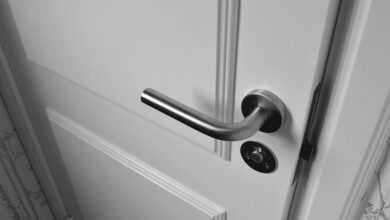Deciphering the Art of Lock Picking
KEY TAKEAWAYS
Lock picking is the art of manipulating the components of a lock in order to unlock it without using the proper key. While many people associate lock picking with criminal activity, it is also a valuable skill for locksmiths and security professionals.
Lock picking involves understanding the mechanics of various types of locks, such as pin tumbler locks commonly used in residential settings. By using the right tools and techniques, it is possible to pick these locks and gain entry without causing damage or destruction. The goal of lock picking is to skillfully manipulate the lock mechanism and bypass its security measures, allowing for a non-destructive entry into locked spaces.
How to Pick a Door Lock Without Tools
Locking yourself out of your own house can be incredibly frustrating, but don’t worry – you may not need any traditional lock-picking tools to get back inside. With a little creativity and resourcefulness, you can still pick a door lock without any specialized equipment. Here are four alternative methods using everyday household items:
Bobby Pin Method
Straighten out the bobby pin and bend the end into a small hook. Insert the straightened end into the keyhole and use it to feel around for pins. Apply slight pressure to the pins and use a raking motion to try to set them into place.
Paper Clip Method
Straighten out a large paper clip and bend one end at a 90-degree angle to create a makeshift tension wrench. Insert the other end into the keyhole and jiggle it up and down to simulate the action of a key. Use the tension wrench to gently turn the lock as you feel for the pins with the paper clip.
Hex Wrench Method
Find a small hex wrench that fits snugly into the keyhole. Insert the wrench into the lock and apply slight pressure to the wrench while jiggling it up and down. In some cases, this pressure can manipulate the lock’s pins and allow you to turn the lock.
Keyhole Method
This method works best for spring-loaded privacy locks. Straighten a sturdy paperclip and insert it into the keyhole. Move it around until you feel the latch bolt, then twist the paperclip to disengage it. The door should unlock and open.
Remember, these methods are not foolproof and may not work for all types of locks. If you are unsuccessful or feel uncomfortable attempting to pick the lock yourself, it is best to contact a professional locksmith to avoid damaging the lock or door.
Types of Locks
Different lock types require diverse techniques for picking without tools. Pin tumbler locks, manipulated by bobby pins or paper clips, align driver and key pins when the correct key is inserted.
Cylinder locks use key picks or a hex wrench to adjust the lock’s pins. While push-button locks, requiring precise button sequence, pose more challenge, a slim jim or plastic card may suffice. Understanding each lock’s basics is key for successful picking without traditional tools.
Pin Tumbler Locks
The Hex Wrench Method is a lock-picking technique applicable to pin tumbler locks, using an Allen wrench to manipulate lock pins. Select a suitable hex wrench; insert the short end into the keyway, applying a gentle turning pressure. Using the long end, manipulate the lock pins with light, rhythmic movements.
Aim to set each pin at the shear line, thereby unlocking the door. This technique requires practice and may not work on all locks. Always exercise caution and attempt only on permissible locks. Remember, lock picking should typically be done by trained professionals.
Doorknob Locks
Doorknob locks, common on residential doors, offer basic security. The lock comprises a cylinder housing the keyhole and a latch bolt. When a key aligns the key pins and driver pins along the shear line, the lock turns and unlocks.
Picking a doorknob lock may involve a card inserted between the door and frame, pushing back the latch bolt. However, without proper tools, picking can damage the lock or door. Unsuccessful attempts should lead to professional locksmith consultation. Understanding these principles is vital if required to pick a doorknob lock.
Cylinder Locks
Cylinder locks are one of the most commonly used types of locks, known for their cylindrical shape and grooves on either side. These locks operate using a system of pins and springs within a core that intersects with the key.
When a key is inserted into a cylinder lock, the grooves on the key align with the pins within the lock. The key pushes the pins upward, causing them to align along what is called the shear line. This creates a gap between the pins, allowing the lock to turn and unlock.
The key’s unique configuration is essential in operating a cylinder lock. The pressure and tension created by the key interacting with the pins in the core enable the lock to function effectively. If the pins are not aligned correctly, the lock will not turn, preventing unauthorized access.
Overall, cylinder locks are widely used due to their reliable security features and ease of use. With their cylindrical shape and grooves, these locks provide an efficient mechanism for protecting residential and commercial properties.
Privacy Locks
Privacy locks are commonly found in residential settings and come in different types such as deadbolts, knob locks, and lever locks. These locks operate using pin tumbler mechanisms, which can be manipulated to open the lock without a key. Understanding the specific lock mechanism is crucial before attempting to pick the lock.
Deadbolts are sturdy, single-cylinder locks that provide higher security levels due to their longer throw bolt. Knob locks, on the other hand, are commonly found on interior doors and can easily be picked using basic lock-picking tools. Lever locks are popular for their ease of use, but they can also be vulnerable to picking.
To pick a privacy lock, the pins within the lock cylinder need to be aligned along the shear line, just like with a regular key. However, without a key, this alignment can be achieved using improvised tools such as a credit card, flathead screwdriver, or a paper clip.
It is important to note that picking privacy locks without proper authorization is illegal and can result in serious consequences. It is recommended to rely on a professional locksmith when faced with a locked door and no key.
Traditional Lock Picking
Traditional lock picking is a technique used to open locks without a key, typically utilizing a tension wrench and a pick. The tension wrench is inserted into the keyhole and is used to apply slight pressure to the lock’s cylinder. The pick is then used to scrub the inside of the lock, manipulating the pins within.
When using the tension wrench and pick, it is crucial to apply just enough pressure to create tension in the core of the lock. Too much pressure can bind the pins, making it difficult to move them. Once tension is applied, the pick is inserted and moved back and forth, scrubbing the pins as it goes.
The objective of traditional lock picking is to lift each pin individually to the shear line, the point at which the pins align and the lock can rotate freely. As each pin is lifted and set, the tension wrench is turned slightly to hold the pins in place. This process is repeated for each pin until all are set, allowing the lock to turn and the door to be opened.
It is important to note that traditional lock picking should only be performed on locks you own or have proper authorization for. It is a skill often employed by professional locksmiths and should not be used for malicious purposes.
In conclusion, traditional lock picking involves the use of a tension wrench and a pick to manipulate the pins within a lock. By applying slight pressure with the tension wrench and scrubbing the inside of the lock with the pick, the pins can be lifted to the shear line, allowing the lock to open.
Basic Lock Picking Techniques
Lock picking is a skill that has been used for centuries to gain access to locked doors. While it is typically performed by professional locksmiths, it is also important for individuals to have some knowledge of basic lock picking techniques. It’s important to note that lock picking should only be used on locks you own or have proper authorization for.
In this article, we will explore some basic lock picking techniques that can be used in emergency situations or when you find yourself locked out. Remember, this information is for educational purposes only and should not be used for illegal activities.
1. Using a Credit Card
One of the most common methods for picking a door lock without traditional lock-picking tools is by using a credit card or any flexible plastic card. This technique is best suited for spring-latch locks commonly found in residential settings. Insert the card between the door and the frame near the latch. Apply slight pressure against the latch while simultaneously wiggling and bending the card to slide it between the latch bolt and the strike plate. With enough persistence and the right technique, you may be able to manipulate the latch and unlock the door.
2. Bobby Pin or Paper Clip Method
Another simple technique that can be used is the bobby pin or paper clip method. Straighten out the pin or clip and bend it into a makeshift pick. Insert the pin or clip into the keyhole and move it around, gently applying upward pressure while attempting to catch and manipulate the pins inside the lock. This method requires patience and finesse, as it may take some trial and error to successfully lift all the pins to the shear line and unlock the door.
3. Using a Slim Jim or Bamboo Skewer
For older cars or certain types of locks, a slim jim or bamboo skewer can be used to pick the lock. Slide the slim jim or skewer down between the window and the weatherstripping. Aim to reach the latch mechanism and manipulate it to unlock the door. This method requires some practice and may not work on all types of locks.
4. Push-Button Locks
Push-button locks can be picked quite easily using a straightened paper clip or a similar thin, rigid object. Insert the paper clip into the hole above or below the knob and push it until you feel resistance. Apply gentle pressure to push the button inside and simultaneously turn the knob to unlock the door.
While these basic lock picking techniques can be helpful in emergency situations, it’s important to remember that lock picking should only be used in lawful and authorized situations. If you find yourself locked out and unable to use these techniques, it is best to contact a professional locksmith who can safely and legally assist you in gaining access to your property.
Bobby Pin Method
The Bobby Pin Method is a popular technique for picking a door lock without traditional lock-picking tools. It involves using a bobby pin, or a similar type of safety pin, to manipulate the lock’s pins and unlock the door.
Here are the step-by-step instructions for using the Bobby Pin Method:
1. Straighten the bobby pin: Start by straightening out one end of the bobby pin until it forms a straight line.
2. Create a tension wrench: Bend the other end of the bobby pin into a small L shape to create a tension wrench. This will be used to apply slight pressure to the lock.
3. Insert the tension wrench: Insert the tension wrench into the lower portion of the keyhole and apply a slight amount of pressure in the direction you would turn the key to unlock the door.
4. Insert the bobby pin as a rake tool: Insert the straightened end of the bobby pin into the upper portion of the keyhole. This will act as a rake tool to manipulate the lock’s pins.
5. Rake the pins: Gently move the bobby pin in and out of the keyhole, applying light pressure while raking across the pins. The goal is to push the pins upwards and set them at the shear line to unlock the door.
6. Turn the tension wrench: While continuing to rake the pins with the bobby pin, slowly turn the tension wrench in the direction you would turn the key to unlock the door.
7. Check for movement: As you turn the tension wrench, listen and feel for any slight movement in the lock. This indicates that the pins have been successfully set and the lock is beginning to unlock.
8. Continue raking and turning: If the lock does not unlock right away, continue raking the pins with the bobby pin while simultaneously turning the tension wrench. This may take a few tries, so be patient and persistent.
By following these steps and using the Bobby Pin Method, you can potentially unlock a door with a tumbler mechanism using improvised tools. However, it is essential to note that lock picking should only be used on locks you own or have proper authorization for.
Paper Clip Method
When it comes to picking a lock without traditional tools, one method that can come in handy is the Paper Clip Method. This simple technique involves using a straightened paper clip as both a tension wrench and a lock pick. Here’s how it works:
1. Straighten the paper clip: Start by straightening out a standard paper clip until it forms a long, straight line.
2. Create a tension wrench: Bend one end of the paper clip into a small L shape to create a tension wrench. This will be used to apply slight rotational force to the lock.
3. Insert the tension wrench: Insert the tension wrench into the lower portion of the keyway and apply gentle rotational force in the direction you would turn the key to unlock the door.
4. Use the lock pick: Using the longer straightened end of the paper clip, insert it into the upper portion of the keyway. This will act as a lock pick to manipulate the pins.
5. Scrub the pins: Gently scrub the pins by moving the lock pick in and out of the keyway while applying light pressure. The goal is to push the pins upwards and set them at the shear line to unlock the door.
6. Apply rotational force: While continuing to scrub the pins with the lock pick, slowly turn the tension wrench in the direction you would turn the key to unlock the door.
7. Look for movement: As you turn the tension wrench, listen and feel for any slight movement in the lock. This indicates that the pins have been successfully set and the lock is starting to unlock.
8. Persistence is key: If the lock does not open immediately, keep scrubbing the pins with the lock pick while simultaneously turning the tension wrench. Remember, it may take a few attempts before the lock finally opens.
By following these steps and remaining patient and persistent, you can use the Paper Clip Method to pick a lock without traditional tools.
Hex Wrench Method
The Hex Wrench Method is a lock-picking technique applicable to pin tumbler locks, using an Allen wrench to manipulate lock pins. Select a suitable hex wrench; insert the short end into the keyway, applying a gentle turning pressure.
Using the long end, manipulate the lock pins with light, rhythmic movements. Aim to set each pin at the shear line, thereby unlocking the door. This technique requires practice and may not work on all locks. Always exercise caution and attempt only on permissible locks. Remember, lock picking should typically be done by trained professionals.
Keyhole Method
The keyhole method picks basic pin tumbler locks using any thin, fitting object like a paperclip. Bend it into a straight line with a hook at the end, insert into the keyhole, and apply pressure like turning a key. Manipulate the pins inside with light pressure, setting them at the shear line.
Upon feeling a give in the mechanism, rotate the object, unlocking the door. This method may not work on all locks, especially complex ones. Use only with authorization, respecting legalities around lock picking.
Conclusion
In conclusion, mastering lock picking requires a solid understanding of different lock types and their operation. Remember, improper attempts can lead to lock damage. Therefore, engaging a professional locksmith is highly recommended in complex situations. Always respect legality and privacy when applying lock-picking knowledge.
Read more about the best deadbolt locks from our blogs at Security Forward today.





